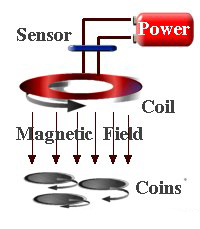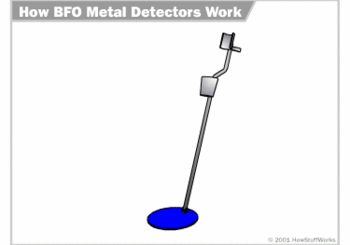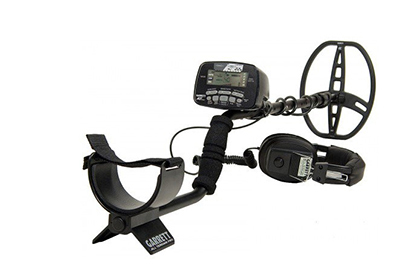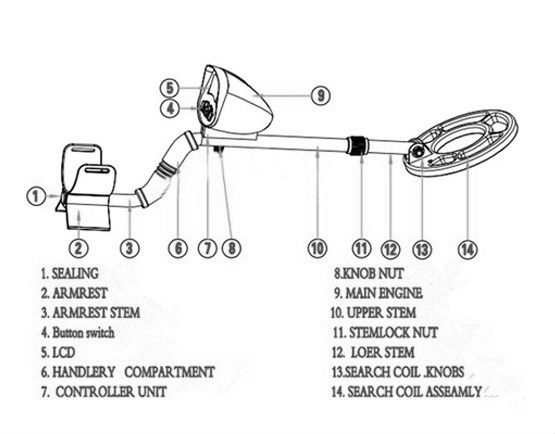Contents
- 1 What Are Metal Detectors & How Do They Work?
What Are Metal Detectors & How Do They Work?
[indeed-social-media sm_list=’fb,tw,goo,pt,li’ sm_template=’ism_template_1′ sm_list_align=’horizontal’ sm_display_counts=’true’ sm_display_full_name=’true’ print_total_shares=1 tc_position=’before’ tc_theme=’dark’ ]A metal detector is an electronic device, which are used by millions of people across the globe to detect nearby metal. The devices work via the science of electromagnetism and are made up of various shapes and sizes and used for a number of different purposes. 
The hobby of metal detecting is a favorite among millions of treasure hunters across the world. The machines used by hunters (metal detector enthusiasts) vary in capabilities but all essentially do the same thing, uncover metal from the ground.
Metal detectors are also a prominent feature at airports and used at large sporting events for security. They are used by our military and security services to help uncover mines, guns and other weapons and generally help to keep the world a safer place.
In this article I’m going to explain how different types of metal detectors work, who they were invented by and provide some handy tips on ground balancing and discrimination features.
Who Invented The Metal Detector?
The invention of the metal detector dates back to the 1800’s after the invention of electricity. They were used by gold miners during the gold rush for prospecting and also by scientists who were experimenting with finding metal in the ground. 
Despite this earlier use the invention of the metal detector is credited to Alexander Graham Bell in 1881. Bell was hired to invent a device to locate a bullet which doctors were unable to locate on President James Garfield. Garfield was shot in the back in Washington July 2nd and although he survived the attack initially he later died from the infected wound.
Although Bell had invented a viable metal detector, which was later used as a prototype for future devices, the metal springs in the President’s bed had puzzled the device and the bullet was not located.
Although the first devices were large in size, featuring a vacuum tube they predominately featured in both WWI and WWII to locate land mines and un-exploded bombs.
Gerhard Fischer
During the early 1900’s, Gerhard Fischer founder of Fisher Metal Detectors was working as a research engineer studying aircraft radio detection finders. His solution to the problem of ore bearing rocks distorting the navigational systems, led him to share an idea with Albert Einstein of a portable metal detector, which was eventually granted a patent.
Fisher Reviews:
Further Development
The hand held metal detector has seen continued development since the patent was granted to Fischer in 1925. Charles Garrett founder of Garrett Metal Detectors played a major part in this development having taken up metal detecting as a hobby in 1960.
Garrett became frustrated at failing to find a metal detector which could perform to how he wanted. In the end he decided to invent his own, developing search coils and eliminating oscillator drift, a technology he was to also patent.
With the hobby becoming more and more popular and the huge technological advancements being made generally the future for the metal detector looks bright.
How Do Metal Detectors Work?

A metal detector works via the search coil attached to the bottom of the device transmitting an electromagnetic field into the ground. This electromagnetic field will trigger any targets (metal objects) to transmit an electromagnetic field of their own in response, which is received by the machines coil.
The coil will send an alert to the user of the received electromagnetic field by signalling a target response.
Different Types Of Metal Detector
There are currently 3 different types of metal detectors available:
Beat Frequency Oscillation

A beat frequency oscillation (BFO) system is generally the most basic technology to detect metal in the ground. The system works by way of two coils of wire, one located in the head and the other located in the machines control box.
The two coils of wire are connected to an oscillator (hence the name) that has the capacity to generate several thousand pulses of current every second. When the pulses travel through each coil they generate radio waves, which are picked up by a receiver based in the devices control box. The receiver alerts the user by creating an audible hum (series of tones) which are based on the frequency difference.
The simplicity of the BSO technology means these devices can be manufactured at a reasonably low cost, which is passed onto consumers. Although some would argue they are a good entry level device, they seriously lack the level of accuracy found in VLF and PI technology
Very Low Frequency
Very low frequency (VLF) technology is probably the most popular metal detector technology and used within the majority of devices available on the market today. 
VLF works by way of two coils, the transmitter and receiver. The transmitter coil is is the outer coil loop, which produces a strong electric current in 2 directions. The frequency of the detector is established dependent on the number of times the current switches direction.
The receiver coil which is the inner coil loop detects and amplifies frequencies from targets in the ground.
They work together via the transmitter coil looping the strong electric current both above and below the surface of the ground. When the current comes into contact with a metal target it causes an interference picked up by the receiver coil, which causes it to magnify and can be heard via the audio system.
VLF detectors are more powerful, more accurate and generally cost more money than BFO machines.
Pulse Induction Detectors

Unlike the VLF detectors pulse induction (PI) technology works by way of a single coil acting as both the transmitter and receiver. The coil transmits pulses of electricity into the ground creating a magnetic field. When the pulses hit a metal object in the ground, the magnetic field is reversed and a signal sent out.
PI detectors are generally more expensive and perfect for use on highly mineralized ground, like the beach. Unlike the VLF detectors they are unable to distinguish between different types of metal and are generally heavier in weight.
The PI technology is particularity effective at detecting gold targets buried deep in the ground and owned as a secondary metal detector by many hunters for this purpose.
Metal Detector Parts Explained

Important Points
- #4, 5 & 9 The detectors main control box. This is the area in which the magic between the transmitter and receiver coil happens. The control box contains the technology that converts any received signals into target responses.
- #14 The search coil sends the electromagnetic field into the ground and receives any return fields generated by targets.
Videos Explaining How Metal Detectors Operate
Best Metal Detector For Beginners

Metal Detecting – Ground Balance
Different types of terrain contain varying levels of ground minerals. As previously mentioned hunting on wet sand can prove problematic to metal detectors due to the high levels of minerals in the ground. To combat this problem ground balance circuitry technology can be used which programs the detector to limit it’s response from minerals in the ground.
Ground balance options included within detectors are usually:
- Fixed
- Auto
- Manual
- Combination
It’s important to note that less expensive machines which are generally used by newbies will likely only feature a single ground balance setting. The setting is factory set, which means it can’t be adjusted and provides limited capabilities in areas with high mineralization.
As you become more experienced with ground balance you will realize the level of mineralization can change drastically quickly (often within just a few feet). In order to combat this problem you will be required to adjust the settings frequently to ensure minimal depth loss.
Articles you maybe interested in:
Metal Detector Discrimination
A discrimination setting on a metal detector works by means of filtering circuitry that blocks the audio or visual alert to certain metal objects. Using this setting basically places trust in your detector to only alert you when specific targets are identified.
There are generally 3 types of discrimination found on metal detectors:
- Variable – Allows users to adjust discrimination levels
- Notch – Users are able to select specific metal types to be accepted or rejected
- Iron Reject – As the name suggests, operators are provided the ability to reject iron junk, particularly useful when hunting for gold.
I hope you found the following useful and have a clearer understanding of how metal detectors work, who invented them and the different types of detector available on the market. I tried to keep this as simple as possible, so hopefully it all makes sense to you. Would love to hear your thoughts via the comment section below and any suggestions as to important things I may have missed are very welcome!
As always
GL & HH
[indeed-social-media sm_list=’fb,tw,goo,pt,li’ sm_template=’ism_template_1′ sm_list_align=’horizontal’ sm_display_counts=’true’ sm_display_full_name=’true’ print_total_shares=1 tc_position=’before’ tc_theme=’dark’ ]
Good metal detector review. Metal detector is an electronic device that are able to detect any kind of treasure. So, its a big decision for me to choose a good metal detector. That why your article is helpful for me to choose a metal detector.